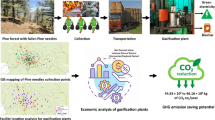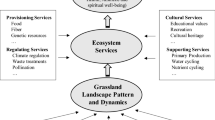Abstract
A set of tools are described for optimal allocation of wood fibre at an operational planning level. These were applied to a case study in Ireland. Allocation was based on optimising net value recovery (delivered price minus harvesting and transportation costs) while meeting market demands and operational constraints (mainly crew capability and productivity limits). Two new models were developed to predict harvesting costs and transportation costs for Irish forest conditions. A new model was developed to link Sitka spruce biomass expansion factors to optimal log-making algorithms so that log and bio-energy product yields could be estimated for individual harvest areas. An existing operational allocation model based on a tabu search heuristic procedure was used. The case study included 16 forest harvest areas and 12 processing plants (saw logs, pallet logs, stakes, pulp, bio-energy slash bundles, etc.). New terrestrial lidar scanning procedures were used to obtain representative stem profiles from over 4,000 trees for the 16 forests. We demonstrated that optimal allocation of bio-energy and log products, while complex, can be achieved through the use of appropriate management tools.



Similar content being viewed by others
References
Berwick M, Farooq M (2003) Truck costing model for transportation managers. Mountain Plains Consortium, North Dakota State University, Fargo. MPC Report 03-152, p 61
Cossens GP (1996) Optimisation of log allocation. Master of Applied Science Thesis, Lincoln University, New Zealand, pp 124
Devlin GJ, McDonnell K, Ward S (2008) Development of a spatial decision support system (SDSS) for route costing calculations within the Irish timber haulage sector. Trans ASABE 51(2):763–773
ECOWOOD (2002) Factors affecting the productivity of CTL wood harvesting under Irish conditions. ECOWOOD Project. (Draft Report), pp 28
Epstein R, Nieto E, Weintraub A, Gabarro J, Chevalier P (1999) A system for the design of a short term harvesting strategy. Eur J Oper Res 119:427–439
Ferrow G, McKewen BJ (1980) The determination of the profit sacrificed in felling, extraction and log allocation processes. Report of an investigation submitted in partial fulfillment of the requirements of the Degree of Bachelor of Management Studies of the University of Waikato, Hamilton, New Zealand, pp 91 (Unpublished)
Fight R, Zhang X, Hartsough BR (2003) Users Guide for STHARVEST: Software to Estimate the Cost of Harvesting Small Timber. USDA Forest Service, General Technical Report, PNW-GTR-582, pp 18
Firth JG, Brownlie RK, Carson WW (2000) Accurate stem measurements key to new image-based system. N Z J For 45:25–29
Gallagher G, Hendrick E, Byrne KA (2004) Preliminary estimates of biomass carbon stocks in managed forests in the Republic of Ireland over the period 1990–2000. Irish For 61:35–36
Gordon AD, Lawrence ME, Pont D (1995) Assessing the potential log yield of stands prior to harvesting. In: Proceedings of the Institute of Foresters of Australia 16th biennial conference. “Applications of New Technologies in Forestry”, 18–21 April, Ballarat, Victoria
Gordon AD, Wakelin SJ, Threadgill JA (2006) Using measured and modelled wood quality information to optimise harvest scheduling and log allocation decisions. N Z J For Sci 36(2/3):198–215
Green C, Tobin B, O’Shea M, Farell EP, Byrne KA (2007) Above and below-ground biomass measurements in an unthinned stand of Sitka Spruce (Picea sitchensis (Bong.) Carr.). Eur J For Res 126:179–188
Kivinen V-P (2004) A genetic algorithm approach to tree bucking optimization. For Sci 50(5):696–710
Kofman PD, Kent T (2007) Harvesting and processing forest biomass for energy production in Ireland. The Forest Energy 2006 programme. COFORD, Dublin
Laroze A (1999) A linear programming, tabu search method for solving forest-level bucking optimisation problems. For Sci 45(1):108–116
Levy PE, Hale SE, Nicoll BC (2004) Biomass expansion factors and root: shoot ratios for coniferous tree species in Great Britain. Forestry 77(5):421–430
Malone L (1998) Value maximisation of forest stands through optimal inventory and cross-cutting methodologies. Dissertation. University College Dublin, Ireland
Marshall HD, Murphy GE, Boston K (2006) Three mathematical models for bucking-to-order. Silva Fennica 40(1):127–142
Mitchell SA (2004) Operational forest harvest scheduling optimisation—a mathematical model and solution strategy. PhD thesis, University of Auckland, New Zealand, pp 278
Murphy GE (1998) Allocation of stands and cutting patterns to logging crews using a tabu search heuristic. Int J For Eng 9(1):31–38
Murphy GE (2008) Determining stand value and log product yields using terrestrial lidar and optimal bucking: a case study. J For 106(6):317–324
Murphy GE, Wimer J (2007) Controlling truck productivity and costs. In: Proceedings of the international mountain logging and 13th Pacific Northwest Skyline Symposium, Corvallis, Oregon, April 2007, 43–48
Murphy GE, Wilson I, Barr B (2006) Developing methods for pre-harvest inventories which use the harvester as the sampling tool. Aust J For 69(1):9–15
Nasberg M (1985) Mathematical programming models for optimal log bucking. Linkoping University, Dissertation No. 132, pp 200
Pnevmaticos SM, Mann SH (1972) Dynamic programming in tree bucking. For Products J 22(2):26–30
Sessions J, Layton R, Guangda L (1988) Improving tree bucking decisions: a network approach. Compiler 6(1):5–9
Tarleton M, Phillips H (2004) Considerable savings possible by planning harvesting systems. COFORD Connects Harvesting/Transportation 2, pp 8
Tobin B, Nieuwenhuis M (2007) Biomass expansion factors for Sitka spruce (Picea sitchensis (Bong.) Carr.) in Ireland. Eur J For Res 126:189–196
Williamson G, Nieuwenhuis M (1993) Integrated timber allocation and transportation planning in Ireland. Int J For Eng 5(1):7–15
Acknowledgments
This research was undertaken while the first author was a Charles Parsons Visiting Professor at University College Dublin. We acknowledge the assistance of Treemetrics Ltd., which provided a large database of laser scan tree stem profiles, and Coillte Teoranta, which provided access to internal technical reports on conventional and energywood harvesting production studies.
Author information
Authors and Affiliations
Corresponding author
Additional information
Communicated by T. Seifert.
Rights and permissions
About this article
Cite this article
Murphy, G., Lyons, J., O’Shea, M. et al. Management tools for optimal allocation of wood fibre to conventional log and bio-energy markets in Ireland: a case study. Eur J Forest Res 129, 1057–1067 (2010). https://doi.org/10.1007/s10342-010-0390-3
Received:
Revised:
Accepted:
Published:
Issue Date:
DOI: https://doi.org/10.1007/s10342-010-0390-3




